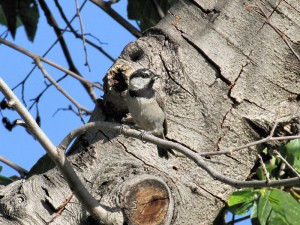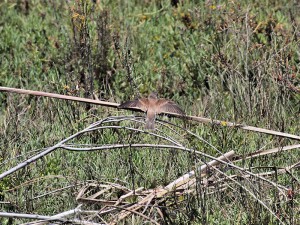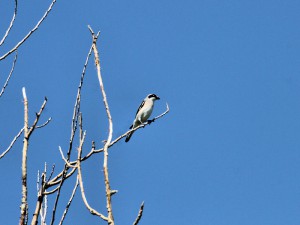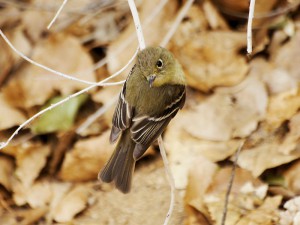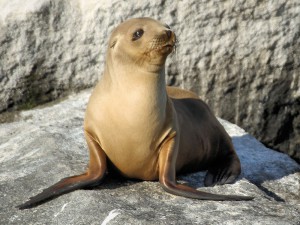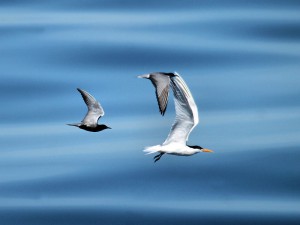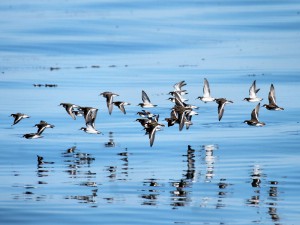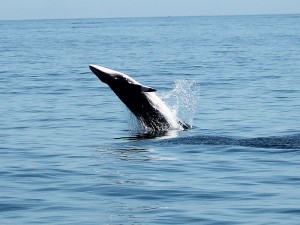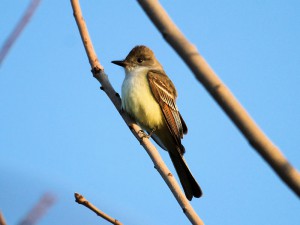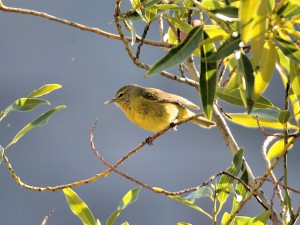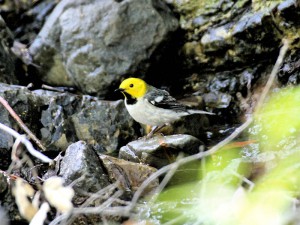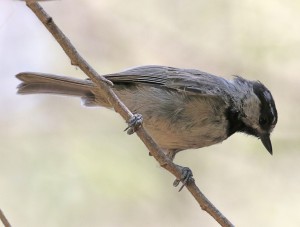Sometimes the best birding occurs right on your doorstep. While riding my bike to work one morning, I heard the telltale song of Mountain Chickadees (Poecile gambeli). I watched one fly over my head into an alder tree beside the road. On the way home, I stopped in the same location to look for the nest I suspected was there. It didn’t take long to find. On an exposed length of trunk some 25 feet up, a fresh-looking hole with a nice, beveled edge was visible. Moments later, one of the parents followed the other to the hole, and the excited calling of the nestlings anticipating food could be heard. I went home and immediately returned with the camera. Then I sat quietly waiting for the adults to return. Continue reading
Author Archives:
Newport Back Bay Science Center
We visited the Upper Newport Back Bay Science Center recently, looking for dragonflies and butterflies. Despite a pleasantly warm morning with relatively little wind, there were very few flying insects out on Father’s Day. The Newport Back Bay Science Center is an educational facility located on Shellmaker Island in the California Department of Fish & Wildlife’s 752-acre Upper Newport Bay Ecological Reserve. While lacking a visitor’s center, this facility is open to the public on a limited basis. They have regular education programs for 7-12th-grade students and other research opportunities, as well as general public visitation hours. There is a lab with multiple tanks of fish and invertebrates like an octopus, starfish, sea urchins and so on. Out back, they have petting tanks with more starfish, small sharks and rays, and flatfish like turbot and halibut. It’s a really neat place! Continue reading
Zeiss Victory SF Experience Tour, Part 4
Our final day of the Zeiss Victory SF tour started on the bus at 4:30 am. We drove for over three hours to a site well south of Budapest, Hungary. The border stop provided us with our first good looks at Crested Larks. These attractive larks commonly inhabit the fields and roadside edges. There was little time to look at them though as we continued the long drive. Our first stop was a great one. We parked along a rural road just outside a tiny town. There we immediately found several Lesser Grey Shrikes. These birds look much like our Loggerhead Shrikes, except they are warmer grey tone in the back and crown. They also show a distinct pinkish wash (photo) to the belly and upper chest.
Also present there were a few European Rollers. These handsome birds are overall sky blue color, slightly darker than Bee-eaters with contrasting reddish-brown wings and back. Rollers are fairly large, being slightly bigger and rather stockier than a Western Scrub-Jay. They are named for their looping roller-coaster-like display flights, which we got to see briefly, sadly only at great distance. Also present at this site was a hunting Little Owl that kept popping up onto a distant fence post. A pair of lovely Stonechats flew about the margins of a rough field edge. Continue reading
Zeiss Victory SF Experience Tour, Part 3
The next day’s Zeiss Victory SF tour activities started later in the morning. However, some of us were unwilling to let the best birding of the day slide by unused. So a few of us rose at 5:00 am to walk to reedy marshes that spread like fingers into the edge of town. What a great decision! Our first reward was a brief but definitive view of Savi’s Warbler on the marsh edge. Loudly singing its distinctive low-pitched hum of a song; easily overlooked if not focused upon.
Continue reading
Zeiss Victory SF Experience Tour – Part 2
Neusiedler See
For our first day of birding on the Zeiss Victory SF tour, we boarded the bus in Vienna at 6:30 the next morning and headed for Neusiedl am See, our base of operations for the rest of the tour. Neusiedl am See is located on a large lake, the Neusiedler See, in the southeastern part of Austria, nestled in the wine country near the Hungarian border. This lake has extensive marshy edges, making it a haven for waterfowl, herons and shorebirds. With laudable directness, we drove right past our lodgings and got straight to the birding, traveling clockwise round to the southeastern shore of the Neusiedler See. Continue reading
Zeiss Victory SF Experience Tour, Part 1
I just got home from attending the Zeiss Victory SF Experience tour. This press event celebrated the release of their new world-class SF Binocular. Zeiss took us on a tour of their factory in Wetzlar, Germany. There we saw how they assemble their new Victory SF binoculars. The extensive testing they do ensures a high level of quality control. That visit impressed all of us! Between traveling and a tour of the lovely old town section of Wetzlar Germany, we birded little on our first day.
Much of our birding time there involved common hedge and garden birds. Anyone with much European birding experience knows these birds intimately. Since I’d not previously visited continental Europe, these common birds delighted me! I enjoyed common birds like Chiffchaff, Blackcap, Black Redstart, Short-toed Treecreeper, Fieldfare, Serin and others. It was also a chance to get to know my fellow trip participants. There were a lot of really good birders on this trip, and I benefited greatly from their experience and knowledge. Continue reading
Northwest Mojave Migrant Traps
We made a May 18th run up to the migrant traps of the northwest Mojave and southern Kern County recently. It was probably a bit early for such a trip, but there wasn’t much going on down in Orange County. And you never know what you will find up there. We left at an ungodly hour and arrived at Butterbredt Spring, the Audubon California Kern River Preserve, shortly after dawn. It wasn’t a great day for it: the wind was whipping at a steady 25 mph. But even on the road in from Jawbone Canyon, we could see lots of birds on the move. Despite the blow, Wilson’s Warblers, Swainson’s Thrushes and flycatchers were crossing the road in droves. They stayed low to the ground, contour flying out over the open desert hills.
Butterbredt Springs
The preserve itself was simply alive with birds. We saw 5 species of warbler, 9 species of flycatcher and assorted passerines, like Lazuli Buntings and Black-headed Grosbeaks. One great thing about a morning like this is the chance to study difficult species like the (Empidonax) flycatchers. It’s always nice to have a chance to compare and contrast this difficult group in terms of their structural differences. We recorded five species of Empids that day, with Pacific-slope and Willow Flycatchers being the most common. A few Hammond’s, Dusky and Gray Flycatchers put in an appearance as well. We also had great looks at Olive-sided Flycatchers and Western Wood-Pewees (photo) together. Watching these similar species side-by-side at close range made their structural differences much easier to see. Listening to them talk, particularly the two commonest Empid species, was also a pleasure. Continue reading
Spring Pelagic Trip in Orange County
I took the Sea & Sage Audubon spring pelagic trip out of Dana Point on 03-MAY-14. It was a glorious eight hours of birding on a glassy calm Pacific Ocean with cool temperatures and almost no breeze. The trip started with us cruising past one of Orange County’s only nesting pairs of Black Oystercatchers on the breakwater. This young California Sea Lion pup loafing on the rocks was too adorable to ignore. Once out to sea, pelicans, gulls and terns soon began congregating behind the boat. Popcorn works every time! This pelagic trip featured low numbers, but a good variety of birds.
Gulls and Terns
We had a good variety of terns, including Caspian, Elegant, Forster’s, Common, Least and Black Terns. These terns lifted up off a floating kelp raft. The gulls were fairly mundane, including California, Western, Heermann’s, and Bonaparte’s, with one exception. A group of eight Sabine’s Gulls encountered near Catalina Island gave provided a thrill. The group included three fully hooded adults. Now that’s a snazzy bird! Any day you see a Sabine’s Gull in Orange County is a good day of birding by definition! Hence, this was a very good day.
Alcids and Shorebirds
We did well for true seabirds as well, with a single Black-vented Shearwater, three languidly flying Pink-footed Shearwaters and dozens of Sooty Shearwaters, most of which were in such ragged molt it was a wonder they could get airborne. Unfortunately, we saw only two distant Black Storm-Petrels all day. We observed all three of the expected loon species (Common, Pacific and Red-throated) multiple times. Scripp’s Murrelets, a dozen or so Cassin’s Auklets, and one sub-adult Rhinoceros Auklet represented the Alcidae. Several groups of Scripp’s Murrelets included flightless young ones, though they still dive like pros! We kept running across large rafts of phalaropes, more than 90% of which were Red-necked Phalaropes like these shown here. There were isolated Red Phalaropes feeding on kelp rafts, and occasionally mixed in with the Red-necked.
Marine Mammals
Marine mammals, rather than birds, provided the best show of the day In addition to the California Sea Lions, we also saw Stellar’s Sea Lions, Northern Elephant Seals, Bottle-nosed Dolphins and three different Minke Whales. The first pair of Minke Whales were quite friendly, circling the boat and obligingly surfacing repeatedly for photos. But on the way back to the harbor, we encountered one that got playful with us, dashing under the boat and then fully breaching right up close. Though lots of people missed the original jump, that Minke proceeded to breach 4 more times! What a glorious way to end a trip. I used a Canon EOS Rebel T3 camera and a 100-400 mm zoom lens for these shots.
Mid-April Migrants
Recently, we took a trip to one of the local canyons in the Santa Ana mountains in search of mid-April migrants. We hit the jackpot almost immediately. Right away, this handsome Ash-throated Flycatcher (Myiarchus cinerascens) greeted us in the parking lot. Surprisingly, he was pretty cooperative too. We stopped in a dry foothill canyon to listen for sparrows. First, Lazuli Bunting, Black-chinned Sparrow, Rufous-crowned Sparrow, Lesser Goldfinch, Western Tanager rewarded us. Typically, California Thrasher, Bewick’s Wren and both Blue-gray and California Gnatcatchers were there, along with California Towhee, Phainopepla and a distant Coastal Cactus Wren.
Silverado Canyon
Next, we went to our target destination: Silverado Canyon. The reported MacGillivray’s Warbler, a much sought-after mid-April migrant, ultimately called loudly enough to be heard over the stream. Mountain Quail were calling from all over everywhere. Pacific-slope Flycatchers worked the under story over the creek. Following that, a wave of common warblers came through: Wilson’s, Townsend’s, Black-throated Gray, and a few Nashville Warblers. A handful of late Yellow-rumped Warblers of the Audubon’s race also showed up. Some of the Orange-crowned Warblers (Oreothlypis celata) annually stay and breed here. And the morning light was perfect for photography too.
Other Migrants
Surprisingly, the vireos put in a good showing too, with half a dozen migrant Warbling Vireos and at least two singing Cassin’s Vireos. Perhaps the most common vireos were the vocal resident Hutton’s. An early Western Wood-Pewee sang its distinctive song in the distance, a perfect complement to the activity in front of us. Later, at a stream crossing with shallow pools, we found migrants coming in to bathe and drink. Hermit Thrushes stood by shyly as the warblers boldly splashed about. This lovely male Hermit Warbler (Setophaga occidentalis) gave us quite a show. Some of these bathing birds were so busy, they let us approach quite closely. Thus, even small birds like these warblers were huge in the 10×42 Zeiss Victory SF binoculars we were lucky to be using. It’s pretty hard to beat that kind of frame-filling view of such beautiful birds!
Lastly, I shot these photos with a Canon EOS T3 equipped with a 100-400 mm zoom lens.
My Little Chickadees
The chickadees and titmice of North America belong to a small family (Paridae) without many North American representatives. The Paridae, unlike say warblers, sparrows or woodpeckers, seldom have many members of the family present in the same habitat and locations. For example, southern California, we typically only have one chickadee and one titmouse species in any given area, and some areas have none, since they are generally forest or edge habitat specialists.
Chestnut-backed Chickadees
In southern California, the chickadees are typically much less widespread than the titmice. For chickadees, there are really only two: the Chestnut-backed Chickadee (Poecile rufescens), and the Mountain Chickadee (Poecile gambeli). Chestnut-backed Chickadees occur mainly along the coast, mostly confined to the coastal plain. Look for them from the middle of California up to southern Alaska. In northeastern Oregon, eastern Washington, northern Idaho and southeastern British Columbia, there is a discontinuous range segment more inland. Most authorities recognize three races of Chestnut-backed Chickadee. Generally, the central California race shows the least color, with little to no rufous wash along the flanks. We found this bird among a group of 3-4 at Douglas Family Park on the bluffs above Santa Barbara. The furthest south we’ve ever observed this species.
Mountain Chickadee
The Mountain Chickadees range widely from the Davis Mountains of west Texas across to the coastal plain in San Diego County. They also inhabit much of New Mexico, Arizona, Nevada, Colorado, Wyoming and Montana, and Idaho. In Canada, they live in extreme southwestern Alberta and most of British Columbia, wherever there are mountains. Recently, here in Orange County, our Mountain Chickadees staged a dramatic spread to lower elevations. Surprisingly, several bands of birds apparently breed at nearby Serrano Creek, at well below 2000 feet of elevation. We photographed this particular individual at a more typical location: at over 7000 feet along the Angeles Crest Highway.
Finally, we took these shots with a Canon EOS T3 Rebel camera and a 100-400 mm IS zoom lens.

